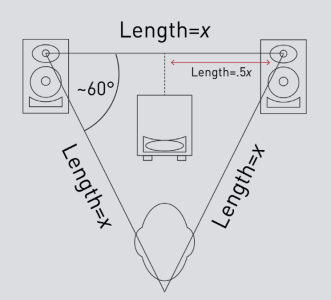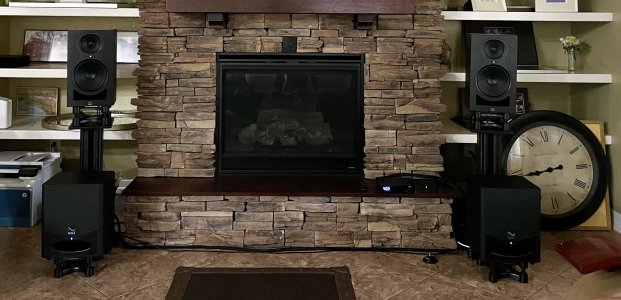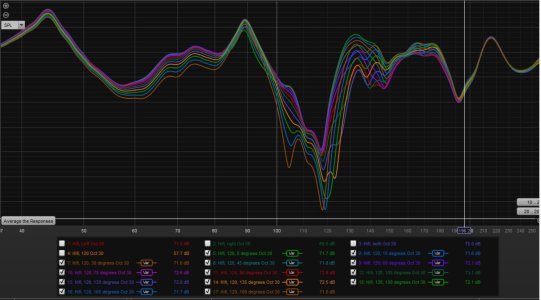You are using an out of date browser. It may not display this or other websites correctly.
You should upgrade or use an alternative browser.
You should upgrade or use an alternative browser.
2.2 active set up
- Thread starter jed1
- Start date
alpha_zulu
Senior Member
Looks really cool. But WAF of your equipment is very low, or?
steadyshot
Major Contributor
- Joined
- Mar 14, 2023
- Messages
- 882
Is there even one time you prefer using foot switch to toggle full range to mains ? I bet it sounds amazing with the subs
They are configured as stereo pair - no summing of left and right. Left (right) output from DAC goes through left (right) subwoofer and left (right) main. Timing is aligned between sub and main because they are co-located. Sub and main act together as a full-range 4-way speaker.How are you aligning the two subs together, and eqing the summed subwoofers?
They are configured as stereo pair - no summing of left and right. Left (right) output from DAC goes through left (right) subwoofer and left (right) main. Timing is aligned between sub and main because they are co-located.
Some subs will have a delay, due to the plate amp, even if they're located right next to each speaker doesn't mean they're in phase with the mains.
Good idea to EQ subs, minidsp will allow you to use dedicated left and right input and left and right output.
If you have UMIK 1 and REW, plot response of left sub, right sub, combined subs, and subs and speakers, to see how mains subs interacts with mains.
Here is my test of what a sub phase (test every 15 degrees) does to sub + mains response. Factor in you have one more sub.....
Attachments
Yeah. See:Some subs will have a delay, due to the plate amp, even if they're located right next to each speaker doesn't mean they're in phase with the mains.
Timing is aligned between sub and main because they are co-located. Sub and main act together as a full-range 4-way speaker.
Nice setup, @jed1.
With a crossover frequency as low as 80 Hz you could even try placing the sub behind the mains, getting more gain from the room boundaries. This would require a new time alignment, of course, and equally important a different EQ (saving subwoofer amplifier power).
Maybe someday, I would get a miniDSP Flex to fully adjust 2 mains + 2 subs. Until then, I enjoy the current set up.
It's quite interesting seeing how variable phase effects combined system response, if you look at mine. If those sub amps are class D with any DSP there will be a delay.
Having duals makes it even more complex, my response with duals, not time aligned, not EQ'd was awful.
As I understand it (i might be wrong) if the sub has a delay, then in effect you want the sub at a different physical distance to the speakers to compensate for the sub plate amp (ignoring whether that other location is better or worse for bass) It's quite complex and I have basic knowledge as it is.
That's why when Wiim have delay calibration measurement added to their products on the dedicated sub out will be a useful feature.
But this is the entire idea: There's no need for changing the physical distance if you can adjust delay on the device managing the sub.As I understand it (i might be wrong) if the sub has a delay, then in effect you want the sub at a different physical distance to the speakers to compensate for the sub plate amp (ignoring whether that other location is better or worse for bass) It's quite complex and I have basic knowledge as it is.
However, regarding the setup of @jed1 I totally missed the point that sub management is not handled by the WiiM Pro Plus. Since this is not the case, it's probably best to keep subs and mains as close together as possible, indeed.
It really depends. Detecting the correct delay between subs and mains automatically based on acoustic measurements is quite a tough job because of the limited bandwidth of typical suboofers. Another option is to offer individual input fields for distance (manually measured) and for subwoofer delay (value provided by sub manufacturer). The software would then calculate the total delay and apply it.That's why when Wiim have delay calibration measurement added to their products on the dedicated sub out will be a useful feature.
No matter how we look at it, it's never easy if you cannot perform good quality measurements on your own. REW and the UMIK-1 are surely a very reasonable investment. But even then it takes a bit of learning.
yeah stereo and sub or subs makes it pretty complex. You can't delay the mains on a regular analogue hifi pre amp
to compensate for the sub DSP, antimode/minidsp, or if sub or subs and speaker are in different physical locations.
some reading

 forums.audioholics.com
forums.audioholics.com
to compensate for the sub DSP, antimode/minidsp, or if sub or subs and speaker are in different physical locations.
some reading

Does DSP latency matter?
Many subs have DSP's which delay the signal. I know an AVR with Audyssey corrects for this, but for those of us wanting to use a 2 channel receiver for music, is this something that just doesn't matter much? There are many reviews of subs with DSP, but they never seem to mention timing as an...
But you can using e.g. the WiiM Amp, which makes it quite superior to most competitors.You can't delay the mains on a regular analogue hifi pre amp
to compensate for the sub DSP ...
I agree to the point about the delay due to DSP. My mains (Kali IN-8 V2) are also heavily DSP-ed active speakers (with active 3-way crossover and boundary EQ's. DSP crossover only takes upto 3 biquads and a couple of shelf/peaking filter). Attached is the placement guideline by manufacturer for 2.1 set up. They designed the sub to match their own monitors so I believe the timing was considered for such configuration. I use them as mid-field (10-12ft) not near-field and put each sub right next to the mains.It's quite interesting seeing how variable phase effects combined system response, if you look at mine. If those sub amps are class D with any DSP there will be a delay.

I thought about DSP latency on sub and effect on main. Since my mains are fed with high-pass output from the subs, subwoofer's DSP latency is already built into the high-pass outputs to main. In other words, the sub acts as DSP crossover. For this case, no need to worry about effect of DSP latency.I agree to the point about the delay due to DSP. My mains (Kali IN-8 V2) are also heavily DSP-ed active speakers (with active 3-way crossover and boundary EQ's. DSP crossover only takes upto 3 biquads and a couple of shelf/peaking filter). Attached is the placement guideline by manufacturer for 2.1 set up. They designed the sub to match their own monitors so I believe the timing was considered for such configuration. I use them as mid-field (10-12ft) not near-field and put each sub right next to the mains.
View attachment 8492
I thought about DSP latency on sub and effect on main. Since my mains are fed with high-pass output from the subs, subwoofer's DSP latency is already built into the high-pass outputs to main. In other words, the sub acts as DSP crossover. For this case, no need to worry about effect of DSP latency.
Some subs have adjustable delay on high pass outputs, my sub does and allows adjustment.
Don't presume yours has, and is correct, you need adjustable delay.
I thought about DSP latency on sub and effect on main. Since my mains are fed with high-pass output from the subs, subwoofer's DSP latency is already built into the high-pass outputs to main. In other words, the sub acts as DSP crossover. For this case, no need to worry about effect of DSP latency.
I've just setup a sub in my system, it's slightly unsual connection, but you can see subs phase effects combined response, so you want delay and/or phase (similar but slightly different effect) to be right
Speakers are small bookshelf 80hz F3, set to full range (pure mode)
Switched sub off, set Left speaker to 75db in REW spl meter. Disconnected speaker cable, powered up sub, set sub to 75db. Reconnected cable.
subwoofer is receiving the same low level signal. Low pass is disabled for this testing
Sub has phase adjuster 0-180, every 15 degree steps, so I did a full range sweep, for left/sub at the same time.
You can see how phase effects combined left speaker + sub response.
I don't know why the bass response is so bad, it's a 13" 1000" sealed sub :-/
Attachments
Similar threads
- Replies
- 6
- Views
- 976
- Replies
- 3
- Views
- 467
- Article
- Replies
- 88
- Views
- 7K
- Replies
- 52
- Views
- 5K



